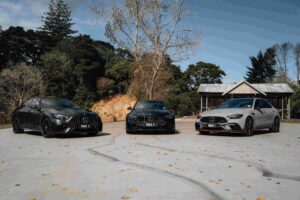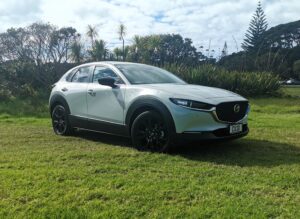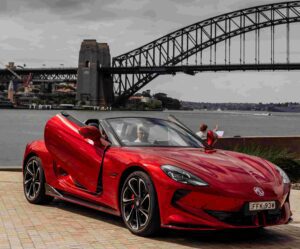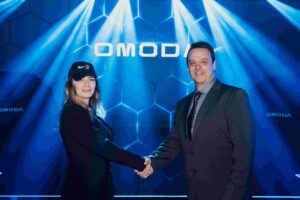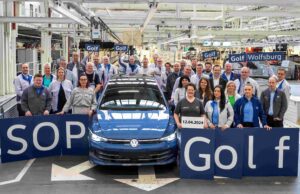Alright, so cards on the table, I’m still a big fan of the Simpsons. Regardless of how many times I seem to watch any episode, I still manage to see or hear something new from that crazy yellow family that makes me smile. Unfortunately however; I do manage to liken many real-life situations to scenes from the show – doh. Case in point was my recent visit to the McLaren Headquarters in Woking Surrey, UK, a place that in my mind was akin to Globex.
Located in Cypress Creek, USA, Globex is a (fictional) High Tech company that is THE place to work. It’s an environmentally green corporation that panders well to its employees. It doesn’t believe in walls (only windows), is lavished with greenery inside and out, and has a casual approach to its dress code. With evil genius and philanthropist (so he can’t be all bad) Hank Scorpio at its helm, it’s a progressive business that just happens to be out for world domination. You’ll share my connection very soon.
 Call it lucky (from a traffic point of view) if you like, but my high anticipation following the invite, and my crack of dawn start; meant that I arrived at McLaren’s headquarters VERY early. Many would see this as a bit of a negative, but with a coffee in hand, picked up from a nearby barista (a machine at a local service station), I ‘staked out’ the Woking facility’s entrance and watched the comings and goings – of which there were plenty. Droves upon droves of dark coloured vans and minibusses ferreted people and (I assume) products, past the security booth with this sinister visage being frequently interrupted with a glorious assortment of McLaren supercars in various colours of the rainbow, thus making it a car spotters dream.
Call it lucky (from a traffic point of view) if you like, but my high anticipation following the invite, and my crack of dawn start; meant that I arrived at McLaren’s headquarters VERY early. Many would see this as a bit of a negative, but with a coffee in hand, picked up from a nearby barista (a machine at a local service station), I ‘staked out’ the Woking facility’s entrance and watched the comings and goings – of which there were plenty. Droves upon droves of dark coloured vans and minibusses ferreted people and (I assume) products, past the security booth with this sinister visage being frequently interrupted with a glorious assortment of McLaren supercars in various colours of the rainbow, thus making it a car spotters dream.
With clockwork precision, my timeslot had appeared and so did the security guard – it was time to go in.
The 50Ha site is vast, especially for a county such as Surrey, but the MTC is cleverly (or is that sinisterly) unobtrusive thanks to being surrounded by the 100,000 trees and shrubs that McLaren planted and the building’s height being limited to the treeline. Having such a low visual footprint above ground means of course, that much of the facility is subterranean, believe me, there is quite a rabbit warren underfoot.
 From the air (just like Globex you can get there by helicopter), the 57,000m2 main building of the MTC has a yin/yang look about it, it’s almost spiritual, and with good cause. It appears that Woking has a strong connection with the McLaren family and the land the facility is built on; offers deep-seeded cultural roots, albeit 20,000km from New Zealand.
From the air (just like Globex you can get there by helicopter), the 57,000m2 main building of the MTC has a yin/yang look about it, it’s almost spiritual, and with good cause. It appears that Woking has a strong connection with the McLaren family and the land the facility is built on; offers deep-seeded cultural roots, albeit 20,000km from New Zealand.
Alas, I had arrived by car not air; but fear not, the view is just as impressive. The path to reception leads you around a beautiful (and large 50,000m3) man-made lake that doubles as (no not a missile launching pad) a cooling source for the building’s Air Conditioning. And this is just the beginning of the ‘functional smarts’ that the MTC has up its sleeve. The MTC is carbon neutral and very biodiverse. The lake and reedbeds have created new habitats, recycled tyres have been used for the roof and two gas-powered trigeneration units provide renewable heat, cooling, and electricity for the building. At over 1000 employees, McLaren is the largest supplier of jobs for the area, and to keep everyone happy, (aside from working on the supercars) there is a large canteen, gym, and even a swimming pool – you see, all very Globex.
Under its 7m wide cantilevered roof and hugging the waterline, is the curved, glass-fronted MTC building and the slow crawling drive around the lake offers you a first glimpse of the cars that await you inside – take that helicopter travellers!
 When you enter the expansive reception area, you enter the life and times of the McLaren brand itself. A story that is unveiled by show rather than tell. And what better way to begin, than being greeted with Bruce McLaren’s first car – the personally engineered #58, 1929 Austin 7 Ulster that Bruce McLaren raced as a boy, and won his first race in 1954. It’s so basic in nowadays terms, but incredible in its day – evidently.
When you enter the expansive reception area, you enter the life and times of the McLaren brand itself. A story that is unveiled by show rather than tell. And what better way to begin, than being greeted with Bruce McLaren’s first car – the personally engineered #58, 1929 Austin 7 Ulster that Bruce McLaren raced as a boy, and won his first race in 1954. It’s so basic in nowadays terms, but incredible in its day – evidently.
We then slowly wandered around the Boulevard of fulfilled dreams, taking in all that was on offer and letting the story unfold.
 The 1960’s
The 1960’s
Standing proudly alongside the 1929 Austin 7 is a 1968 M7A made for the F1. Designed by Robin Herd and Gordon Coppuck, the M7A it was the first McLaren powered by the Ford Cosworth DFV engine. It came second in the Constructors’ title in ’68, won the Italian and Canadian Grand Prix with Denny Hulme at the wheel, and a car in which Bruce McLaren himself took out the Belgian Grand Prix.
 Next up was the 1968 CAN-AM M8A (part of the newly styled and very successful M6A era). The M6A was arguably one of the finest handling machines of its time and helped Bruce and Denny Hulme dominate the 1967 Can-Am series, winning five out of six races. The M6A was also the first McLaren to be painted in the team’s trademark papaya orange – or McLaren Orange as is now known. Unfortunately, this was also the car (M8D) that Bruce lost his life in. There was a notable pause; before we moved on in decades and styling.
Next up was the 1968 CAN-AM M8A (part of the newly styled and very successful M6A era). The M6A was arguably one of the finest handling machines of its time and helped Bruce and Denny Hulme dominate the 1967 Can-Am series, winning five out of six races. The M6A was also the first McLaren to be painted in the team’s trademark papaya orange – or McLaren Orange as is now known. Unfortunately, this was also the car (M8D) that Bruce lost his life in. There was a notable pause; before we moved on in decades and styling.
 The 1970’s
The 1970’s
1971 McLaren introduced the ‘Alligator Car’ (the M19 C) to the F1, and there it was in all it’s Yardley (Sponsor) glory. A 3 season winner, with ‘the Bear’ and new driver Peter Revson.
 Next up, the 1974 M23 B, powered by Ford Cosworth and driven by Hulme, Revson, Mass, Hailwood, Fittipaldi and JAMES HUNT. The line up continued with the 1975 M16 E Indy 500 car. It dominated Indianapolis taking to the podium 9 times out of 11 races (3 of those wins). Then James Hunt’s 1977 M26 ‘Wing Car’ to round off the decade.
Next up, the 1974 M23 B, powered by Ford Cosworth and driven by Hulme, Revson, Mass, Hailwood, Fittipaldi and JAMES HUNT. The line up continued with the 1975 M16 E Indy 500 car. It dominated Indianapolis taking to the podium 9 times out of 11 races (3 of those wins). Then James Hunt’s 1977 M26 ‘Wing Car’ to round off the decade.
The 1980’s
A few feet away was the 1981 MP4/1. It was a hugely significant car for McLaren as they introduced carbon composite (carbon fibre) to F1. The controversy surrounding a light, stiff and strong carbon monocoque was widespread and quite frankly wrong – as proved by Watson’s 140mph crash at Monza, where he walked away but his car (in half) didn’t.
 Next to this were other MP4’s/2-4 of the 80’s, outstanding racing cars, powered by Ford, Porsche and finally Honda, and driven by Watson, Rosberg, Lauda, Cesaris, Johansson, Prost and of course Ayrton Senna. I have to admit to reaching in and touching the steering wheel that these legends have previously held – but it hasn’t upped my driving skills at all.
Next to this were other MP4’s/2-4 of the 80’s, outstanding racing cars, powered by Ford, Porsche and finally Honda, and driven by Watson, Rosberg, Lauda, Cesaris, Johansson, Prost and of course Ayrton Senna. I have to admit to reaching in and touching the steering wheel that these legends have previously held – but it hasn’t upped my driving skills at all.
 Le Mans
Le Mans
Set slightly back from the Formula 1 packs were a group of 3 F1 GTR’s. Consisting of the 1995, BMW powered Kokusai Kaihatsu Le Mans winner, The Gulf Team Davidoff, Longtail and a bright papaya orange one sandwiched neatly in-between.
 The 1990’s.
The 1990’s.
The next group were the MP4’s of the late 90’s, 3 in a row and dressed in silver. With the Mercedes V10 to power them and guided by the likes of Coulthard and Hakkinen, the MP3/13 of the ‘98 F1 season won 8 races and secured McLaren’s first constructor’s title since 1991.
 The backdrop to the vehicle display is the Motorsport development area. Depending on where and when they are on the F1 calendar you can gaze through the glass at the team as they modify the cars, fettling the design wherever possible. There is also a pit lane set up for training on wheel changing etc, and no, I wasn’t allowed to go and play.
The backdrop to the vehicle display is the Motorsport development area. Depending on where and when they are on the F1 calendar you can gaze through the glass at the team as they modify the cars, fettling the design wherever possible. There is also a pit lane set up for training on wheel changing etc, and no, I wasn’t allowed to go and play.
The Naughties
The last group of cars on display were the F1’s of the late 2000’s, resplendent in shiny chrome. Four racing cars starting with the MP4-22. The McLaren ‘22 was controversial in its aerodynamic styling and unique front wing design, it went on to win 8 races but (due to the F1 espionage saga and trouble between their drivers Hamilton and Alonso) didn’t add any silverware to the collection. The 2008 MP4–23 2008 was an evolution of the MP4–22, the car spent over 3,000 hours in the wind tunnel with aerodynamic development continuing throughout the season. Lewis Hamilton took the Drivers’ title by a single point becoming the youngest champion in Formula 1™ history. The 2009 MP4–24 2009 introduced McLaren’s highly sophisticated kinetic energy recovery system. KERS harvests energy during braking and releases it on demand, giving an 80hp boost when required and shaving up to half a second off per lap.
 This vast array of successful cars is actually usurped by the bigger display of awards and trophies. Again beginning with Bruce’s’ 1954 trophy. The impressive collection of silverware lines both sides of a vast corridor that leads towards to MPC (production) and apparently it takes three weeks to polish them all (rather than the 3 minutes it takes to do mine – and even that’s an exaggeration).
This vast array of successful cars is actually usurped by the bigger display of awards and trophies. Again beginning with Bruce’s’ 1954 trophy. The impressive collection of silverware lines both sides of a vast corridor that leads towards to MPC (production) and apparently it takes three weeks to polish them all (rather than the 3 minutes it takes to do mine – and even that’s an exaggeration).
 Located at the end of the corridor is the instantly recognisable Lego 720S. I say instantly recognisable as my (ahem) son has a smaller version. This one, however, took a team of 6, 2000+ hours to put the 280,000 bricks together – pah, it took me less than an hour to build mine, (oops, I mean my son’s).
Located at the end of the corridor is the instantly recognisable Lego 720S. I say instantly recognisable as my (ahem) son has a smaller version. This one, however, took a team of 6, 2000+ hours to put the 280,000 bricks together – pah, it took me less than an hour to build mine, (oops, I mean my son’s).
 Continuing on, we rounded the 145-meter long wind tunnel, with its 4m wide fan that can rotate up to 600 rpm, (my hair was already messy from getting up so early, so no need to venture inside). Then walked along the interconnecting underground tunnel to the production centre, passing by the lecture theatre as we went. Up some steps, or was it down? the labyrinth is rather confusing, before arriving at the observation deck for the production area.
Continuing on, we rounded the 145-meter long wind tunnel, with its 4m wide fan that can rotate up to 600 rpm, (my hair was already messy from getting up so early, so no need to venture inside). Then walked along the interconnecting underground tunnel to the production centre, passing by the lecture theatre as we went. Up some steps, or was it down? the labyrinth is rather confusing, before arriving at the observation deck for the production area.
Like staring at a giant game of twister, the production floor is 33,000m2 of wide open, surgically clean white space, punctuated with an array of brightly coloured Mclaren body paint palettes, and it’s awesome. Watching quite literally, tons of superlight carbon fibre being turned into supercars and hypercars is a sight to behold.
 Racks of monocoque chassis are lined up ready to be wheeled out and get better acquainted with their new bodies. In truth, the production line is surprisingly undramatic (it’s more of a gentle bonding together than an overly aggressive use of noisy pneumatic power tools) but all I have to say is, watching all your favorite modern day McLarens being woven together before your very eyes was simply spellbinding. We unfortunately; were unable to walk the line, but the vehicles themselves doubled back to be completed (with essentially a great big shower) close to the platform we stood upon, (so we were at the start and finish line) before watching the cars being taken out on a short road drive to finish the inspection and QC process – apparently what I witnessed on my ‘stake out’ at the security gatehouse. Ah, the circle of life.
Racks of monocoque chassis are lined up ready to be wheeled out and get better acquainted with their new bodies. In truth, the production line is surprisingly undramatic (it’s more of a gentle bonding together than an overly aggressive use of noisy pneumatic power tools) but all I have to say is, watching all your favorite modern day McLarens being woven together before your very eyes was simply spellbinding. We unfortunately; were unable to walk the line, but the vehicles themselves doubled back to be completed (with essentially a great big shower) close to the platform we stood upon, (so we were at the start and finish line) before watching the cars being taken out on a short road drive to finish the inspection and QC process – apparently what I witnessed on my ‘stake out’ at the security gatehouse. Ah, the circle of life.
With my visit near its end, we walked back through the connecting tunnels and back past the history of cars, with one last vehicle to leer over – the McLaren F1. A technological masterpiece, it was the world’s first carbon fibre road car, the world’s fastest production car and is still the fastest naturally aspirated road car ever built – sigh.
 Alright, so likening McLaren to Globex could be a bit of a stretch, but then again, maybe not. both push boundaries and innovate, both pay particular attention to their employees and both are out to conquer the world, it’s just that McLaren’s focus is on and off the racetrack!
Alright, so likening McLaren to Globex could be a bit of a stretch, but then again, maybe not. both push boundaries and innovate, both pay particular attention to their employees and both are out to conquer the world, it’s just that McLaren’s focus is on and off the racetrack!
“Scorpio! He’ll sting you with his dreams of power and wealth. Beware of Scorpio! His twisted twin obsessions are his plot to rule the world and his employees’ health. He’ll welcome you into his lair like the nobleman welcomes his guest. With free dental care and a stock plan that helps you invest! But beware of his generous pensions, plus three weeks paid vacation each year. And on Fridays, the lunchroom serves hot dogs and burgers and beer! He loves German beer!”
―Hank Scorpio’s theme song
For more McLaren reviews click here



